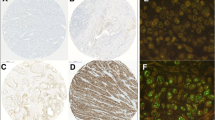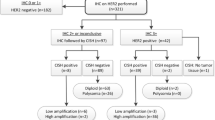Abstract
Background
HER-2/neu (c-erbB-2, HER2) gene amplification and protein overexpression have been associated with poor prognosis in several solid tumors, including breast and gastric cancer. Its incidence and significance in esophageal adenocarcinoma is unknown.
Materials and Methods
Tissue microarrays were successfully constructed from 89 paraffin-embedded archival specimens of esophageal adenocarcinomas for HER2 gene amplification by silver-enhanced in situ hybridization (SISH). No patients had undergone neoadjuvant therapy. Protein overexpression was tested with immunohistochemistry (IHC) using automated immunostaining (Ventana Benchmark). Incidence of HER2 positivity, correlation to clinicopathological variables in esophageal cancer patients, and concordance between SISH and IHC were determined.
Results
True HER2 gene amplification was detected in 14 esophageal cancer specimens (16%), and 92% of those with high-level HER2 amplification showed positive HER2 protein overexpression. No significant associations were found among gene amplification and clinicopathological factors. The 5-year survival rates were 57% for esophageal cancer patients with HER2 amplification compared with 32% without, but the difference in overall survival was not significant (P = .37). The correlation between SISH and IHC was statistically significant (P < .0001).
Conclusion
While molecular targeting may be possible for approximately 16% of esophageal adenocarcinoma patients, HER2 oncogene amplification did not influence survival in this study.



Similar content being viewed by others
References
Thompson SK, Ruszkiewicz AR, Jamieson GG, Esterman A, Watson DI, Wijnhoven BP, et al. Improving the accuracy of TNM staging in esophageal cancer: a pathological review of resected specimens. Ann Surg Oncol. 2008;15:3447–58.
Penault-Llorca F, Bilous M, Dowsett M, Hanna W, Osamura RY, Rüschoff J, et al. Emerging technologies for assessing HER2 amplification. Am J Clin Pathol. 2009;132:539–48.
Walker RA, Bartlett JM, Dowsett M, Ellis IO, Hanby AM, Jasani B, et al. HER2 testing in the UK: further update to recommendations. J Clin Pathol. 2008;61:818–24.
Boone J, van Hillegersberg R, Offerhaus GJA, van Diest PJ, Borel Rinkes IHM, ten Kate FJW. Targets for molecular therapy in esophageal squamous cell carcinoma: an immunohistochemical analysis. Dis Esophagus. 2009;22:496–504.
Sato-Kuwabara Y, Neves JI, Fregnani JH, Sallum RA, Soares FA. Evaluation of gene amplification and protein expression of HER-2/neu in esophageal squamous cell carcinoma using Fluorescence in situ Hybridization (FISH) and immunohistochemistry. BMC Cancer. 2009;9:6.
Arrington AK, Dahlberg PS, Davydova J, Vickers SM, Yamamoto M. ERBB2 suppression decreases cell growth via apoptosis in gastrointestinal adenocarcinomas. Surgery. 2009;146:213–9.
Dahlberg PS, Jacobson BA, Dahal G, Fink JM, Kratzke RA, Maddaus MA, et al. ERBB2 amplifications in esophageal adenocarcinoma. Ann Thorac Surg. 2004;78:1790–800.
Bekaii-Saab TS, Roda JM, Guenterberg KD, Ramaswamy B, Young DC, Ferketich AK, et al. A phase I trial of paclitaxel and trastuzumab in combination with interleukin-12 in patients with HER2/neu-expressing malignancies. Mol Cancer Ther. 2009;8:2983–91.
Lesnikova I, Lidang M, Hamilton-Dutoit S, Koch J. HER2/neu (c-erbB-2) gene amplification and protein expression are rare in uterine cervical neoplasia: a tissue microarray study of 814 archival specimens. APMIS. 2009;117:737–45.
Brien TP, Odze RD, Sheehan CE, McKenna BJ, Ross JS. HER-2/neu gene amplification by FISH predicts poor survival in Barrett’s esophagus-associated adenocarcinoma. Hum Pathol. 2000;31:35–9.
Bang YJ, Cutsem EV, Feyereislova A, Chung HC, Shen L, Sawaki A, et al. Trastuzumab in combination with chemotherapy versus chemotherapy alone for treatment of HER2-positive advanced gastric or gastro-oesophageal junction cancer (ToGA): a phase 3, open-label, randomised controlled trial. Lancet. 2010;376:687–97.
Aly A, Jamieson GG, Pyragius M, Devitt PG. Antireflux anastamosis following oesophagectomy. ANZ J Surg. 2004;74:434–8.
Jamieson GG, Lamb PJ, Thompson SK. The role of lymphadenectomy in esophageal cancer. Ann Surg. 2009;250:206–9.
Graham AD, Faratian D, Rae F, Thomas JS. Tissue microarray technology in the routine assessment of HER-2 status in invasive breast cancer: a prospective study of the use of immunohistochemistry and fluorescence in situ hybridization. Histopathology. 2008;52:847–55.
Nitta H, Hauss-Wegrzniak B, Lehrkamp M, Murillo AE, Gaire F, Farrell M, et al. Development of automated brightfield double in situ hybridization (BDISH) application for HER2 gene and chromosome 17 centromere (CEN 17) for breast carcinomas and an assay performance comparison to manual dual color HER2 fluorescence in situ hybridization (FISH). Diagn Pathol. 2008;3:41.
Scheuemann P, Hosch SB, Izbicki JR. Cytokeratins and other sensitive markers for esophageal cancer and metastases. Dis Esophagus. 2001;14:85–90.
Hofmann M, Stoss O, Shi D, Büttner R, van de Vijver M, Kim W, et al. Assessment of a HER2 scoring system for gastric cancer: results from a validation study. Histopathology. 2008;52:797–805.
Knight WE. A computer method for calculating Kendall’s Tau with ungrouped data. J Am Stat Assoc. 1966;61:436–9.
Fléjou JF, Paraf F, Muzeau F, Fékété F, Hénin D, Jothy S, et al. Expression of c-erbB-2 oncogene product in Barrett’s adenocarcinoma: pathological and prognostic correlations. J Clin Pathol. 1994;47:23–6.
Nakamura T, Nekarda H, Hoelscher AH, Bollschweiler E, Harbec N, Becker K, et al. Prognostic value of DNA ploidy and c-erbB-2 oncoprotein overexpression in adenocarcinoma of Barrett’s esophagus. Cancer. 1994;73:1785–94.
Jankowski J, Coghill G, Hopwood D, Wormsley KG. Oncogenes and onco-suppressor gene in adenocarcinoma of the oesophagus. Gut. 1992;33:1033–8.
Friess H, Fukuda A, Tang WH, Eichenberger A, Furlan N, Zimmermann A, et al. Concomitant analysis of the epidermal growth factor receptor family in esophageal cancer: overexpression of epidermal growth factor receptor mRNA but not of c-erbB-2 and c-erbB-3. World J Surg. 1999;23:1010–8.
Hardwick RH, Barham CP, Ozua P, Newcomb PV, Savage P, Powell R, et al. Immunohistochemical detection of p53 and c-erbB-2 in oesophageal carcinoma; no correlation with prognosis. Eur J Surg Oncol. 1997;23:30–5.
Al-Kasspooles M, Moore JH, Orringer MB, Beer DG. Amplification and over-expression of the EGFR and erbB-2 genes in human esophageal adenocarcinomas. Int J Cancer. 1993;54:213–9.
Duhaylongsod FG, Gottfried MR, Iglehart JD, Vaughn AL, Wolfe WG. The significance of c-erbB-2 and p53 immunoreactivity in patients with adenocarcinoma of the esophagus. Ann Surg. 1995;221:677–84.
Walch A, Specht K, Bink K, Zitzelsberger H, Braselmann H, Bauer M, et al. Her-2/neu gene amplification, elevated mRNA expression, and protein overexpression in the metaplasia-dysplasia-adenocarcinoma sequence of Barrett’s esophagus. Lab Invest. 2001;81:791–801.
Reichelt U, Duesedau P, Tsourlakis MCh, Quaas A, Link BC, Schurr PG, et al. Frequent homogeneous HER-2 amplification in primary and metastatic adenocarcinoma of the esophagus. Mod Pathol. 2007;20:120–9.
Geddert H, Zeriouh M, Wolter M, Heise JW, Gabbert HE, Sarbia M. Gene amplification and protein overexpression of c-erb-b2 in Barrett carcinoma and its precursor lesions. Am J Clin Pathol. 2002;118:60–6.
Tanner M, Hollmén M, Junttila TT, Kapanen AI, Tommola S, Soini Y, et al. Amplification of HER-2 in gastric carcinoma: association with Topoisomerase IIα gene amplification, intestinal type, poor prognosis and sensitivity to trastuzumab. Ann Oncol. 2005;16:273–8.
Rosenberg CL. Polysomy 17 and HER-2 amplification: true, true, and unrelated. J Clin Oncol. 2008;26:4856–8.
Yan B, Yau EX, Bte Omar SS, Ong CW, Pang B, Yeoh KG, et al. A study of HER2 gene amplification and protein expression in gastric cancer. J Clin Pathol. 2010;63:839–42.
Gravalos C, Jimeno A. HER2 in gastric cancer: a new prognostic factor and a novel therapeutic target. Ann Oncol. 2008;19:1523–9.
Grabsch H, Sivakumar S, Gray S, Gabbert HE, Müller W. HER2 expression in gastric cancer: rare, heterogeneous and of no prognostic value – conclusions from 924 cases of two independent series. Cell Oncol. 2010;32:57–65.
Gibault L, Metges JP, Conan-Charlet V, Lozac’h P, Robaszkiewicz M, Bessaguet C, et. al. Diffuse EGFR staining is associated with reduced overall survival in locally advanced oesophageal squamous cell cancer. Br J Cancer. 2005;93:107–15.
Klein CA, Stoecklein NH. Lessons from an aggressive cancer: evolutionary dynamics in esophageal carcinoma. Cancer Res. 2009;69:5285–8.
Francis GD, Jones MA, Beadle GF, Stein SR. Bright-field in situ hybridization for HER2 gene amplification in breast cancer using tissue microarrays: correlation between chromogenic (CISH) and automated silver-enhanced (SISH) methods with patient outcome. Diagn Mol Pathol. 2009;18:88–95.
Rauser S, Weis R, Braselman H, Feith M, Stein HJ, Langer R, et. al. Significance of HER2 low-level copy gain in Barrett’s cancer: implications for fluorescence in situ hybridization testing in tissues. Clin Cancer Res. 2007;13:5115–23.
Acknowledgment
This work was funded by a 2008 Research Grant from the Society of American Gastroenterologists and Surgeons (SAGES). We would like to thank Professor Glyn Jamieson for his constructive comments regarding the manuscript. We also appreciate the efforts of Carolyn Lally, Lorelle Smith, Janet Pinno, and Nicky Ascott in managing the Royal Adelaide Hospital Esophageal Cancer database.
Author information
Authors and Affiliations
Corresponding author
Rights and permissions
About this article
Cite this article
Thompson, S.K., Sullivan, T.R., Davies, R. et al. HER-2/neu Gene Amplification in Esophageal Adenocarcinoma and Its Influence on Survival. Ann Surg Oncol 18, 2010–2017 (2011). https://doi.org/10.1245/s10434-011-1554-1
Received:
Published:
Issue Date:
DOI: https://doi.org/10.1245/s10434-011-1554-1




